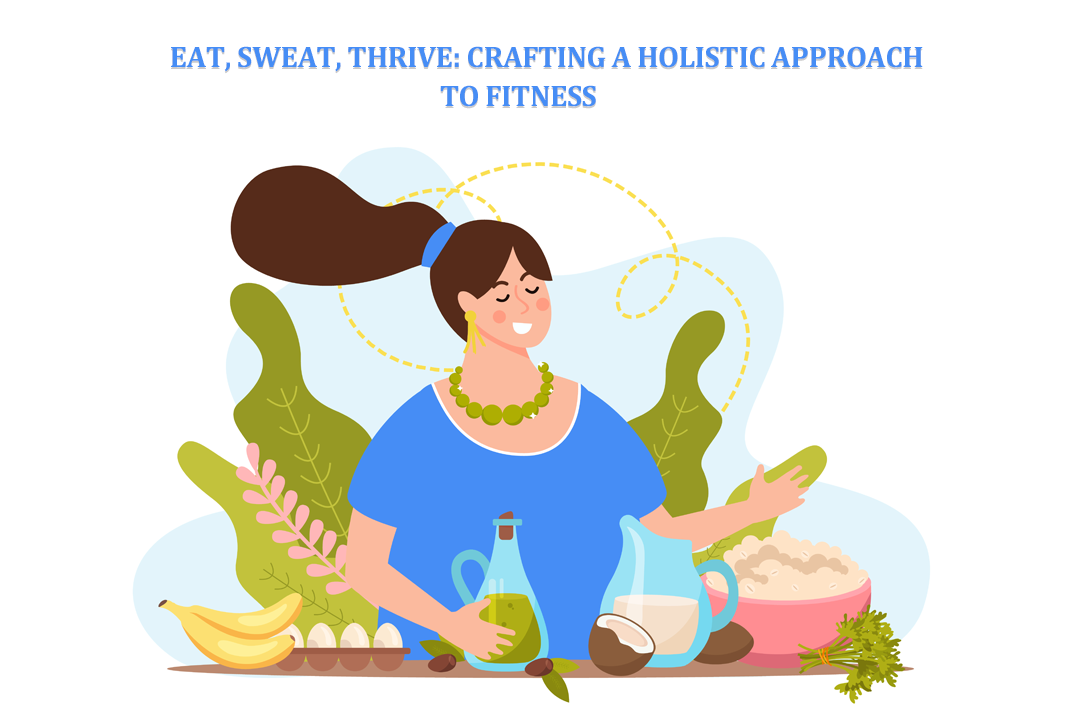When people think of fitness, the only thing that comes to mind is physical fitness. However, proper fitness is not just exercise. For genuine fitness, many other things should be incorporated, including adequate sleep, good nutrition, mental and social health, etc. It is essential to have a balanced lifestyle.
A holistic approach to fitness incorporates all these things, along with others. The three fundamental pillars of a holistic approach to fitness are eating, sweating, and thriving. In other words, nutrition, exercise, along with rest and recovery. These are the most vital things for overall fitness, and a holistic approach includes all of them.
Eating for Holistic Fitness
Let’s discuss this in detail.
The Basics of Nutrition
When eating with holistic fitness in mind, the most vital thing to remember is a balanced diet. With a good diet, your body will have sufficient fuel for all its processes, like growth, regeneration, and repair.
Your diet should be nutrient-rich and contain minerals, vitamins, fats, antioxidants, proteins, and carbohydrates per your body’s requirements. You should neither starve yourself nor gorge yourself on food. Eating in moderation is vital.
Mindful Eating
Mindful eating is an integral part of eating for holistic fitness. It includes paying attention to what you’re eating and paying attention to all the sensations without judgment.
Food is inextricably linked with mood. Certain foods can increase energy levels, promote relaxation, and improve cognitive function. They are beneficial for your body. A few tips to help you eat mindfully are:
- Avoid distractions such as social media while eating.
- Pay attention to your body and eat when you’re hungry. Stop when you’re full.
- Prefer unprocessed foods over processed ones.
- Eat slowly and savour it.
Meal Planning
For a holistic approach to fitness, you must plan your meals carefully. As said before, you should prefer unprocessed foods over processed ones. Choose a variety of foods to eat and focus on whole foods. You should focus more on fruits, lean proteins, healthy fats, vegetables, and whole grains instead of processed meats, packaged snacks, and sugary drinks.
By doing all of this carefully, you will effectively complete the eating portion of the holistic approach to fitness.
Sweating for Holistic Fitness
Let’s look at the second pillar of holistic fitness: sweating.
Exercise as a Fundamental Component
Exercise is an essential component of holistic fitness. It promotes flexibility, endurance, physical strength, and overall well-being. It also improves cardiovascular health and the immune system and boosts mental health. Regular exercise also lessens the risk of disease. It is also beneficial in enhancing the range of motion.
There are many different types of exercises for holistic fitness. These include strength training, cardiovascular conditioning, flexibility, or mind-body practices like yoga.
Tailoring Workouts to Individual Needs
It is essential to find the proper workout for your body’s needs. It is crucial not to overdo training all at once, or else it causes muscle strain. When choosing the right training program, consider what exercise you find enjoyable. For example, you could try swimming or dancing as an exercise.
A good exercise routine includes a mixture of cardiovascular and flexibility exercises, along with strength training. Having a variety of activities in your training is essential to target different muscle groups effectively.
Incorporating Exercise into Daily Life
If you’re only starting to exercise, it is essential to start small. You should gradually increase the intensity of your exercises. Remember to be consistent in your routine. If you have difficulty getting time for exercising daily, add it into your daily life. Forgo the elevator for the stairs whenever possible. Walk short distances for errands instead of driving. You can also use household chores as exercise, like vacuuming or gardening.
Thriving for Holistic Fitness
Finally, let’s talk about the final part of holistic fitness: thriving.
Mental Well-Being
Mental well-being is an essential component of holistic fitness. It includes social, emotional, and psychological well-being. Stress is one of the main disruptors of mental well-being. Thus, it is crucial to manage your stress effectively so it doesn’t impact your mental well-being negatively. Some critical stress management techniques include:
- Meditation
- Mindfulness
- Exercise
- Journaling
- Connecting with nature
- Engaging in hobbies
Quality Sleep
Sleep is necessary for holistic fitness. Getting at least 8 hours of sleep every night is crucial. It helps regulate hormones, improves cognitive function, and helps with muscle repair. As you sleep, your body gets time for self-repair, thus improving endurance and strength, muscle growth, metabolism, and overall health.
For good sleep hygiene, you should create a calming routine before bed. Avoid devices of every sort at least an hour before bedtime. During this time, you can either read or take a warm bath. Your bedroom should be quiet, dark, and cool for quality sleep.
Rest and Recovery
Another crucial part of thriving for holistic fitness includes rest and recovery. As mentioned before, overtraining is bad for your physical health. It can also cause demotivation, fatigue, reduced performance, and injury.
You should also take regular rest days for optimal recovery. On rest days, take some time for your hobbies. You can read, paint, draw, or spend some time building your connection with nature.
Building a Supportive Community
The last part of thriving for holistic fitness is a supportive community; this is part of social well-being. Connect with similar-minded people and be a part of such communities. This way, you will have training buddies. It will also help with motivation.
Integrating the Three Pillars of Holistic Fitness
We’ve studied each of the three pillars of holistic fitness, eat, sleep, and thrive, in detail. Next, let’s find out how to connect each of them with the others.
Creating a Personalized Holistic Fitness Plan
To achieve holistic fitness, creating a personalized fitness plan is essential. When doing this, you must carefully consider lifestyle factors, fitness goals, and preferences. You must also think about your current health and fitness levels. It is best to consult with a certified personal coach or a doctor. They can guide you more effectively in creating a personalized fitness plan.
Tracking Your Progress
It is very beneficial to track your progress. It is necessary for motivation as well. For this purpose, you should use technology. Many fitness apps are available if you prefer to track yourself on your smartphone. Wearable devices are also a good option for fitness tracking. Apart from that, you can also use journaling to track your progress.
Every milestone you reach is something to be celebrated and encouraged. Appreciate your progress for self-motivation. Depending on your progress and evolving needs, you should also make any necessary changes to your fitness program.
Challenges and Solutions
You may face challenges while pursuing your goal of holistic fitness. A common problem is time. People face challenges in taking time from their daily schedules for fitness training, healthy meals, and stress management. If you’re facing this problem, you should plan ahead for your meals. Consider making meals on the weekend for the entire next week. You can also dedicate time in your routine specifically for physical training and relaxing activities. It will help you manage all three aspects of holistic fitness.
Conclusion
In conclusion, the three pillars of holistic fitness are equally important. Holistic fitness is not possible when ignoring a pillar. It is a lifelong journey that can only be achieved with sufficient motivation. For some extra motivation, buy a fitness-themed logo door mat. Every time you step on it, you’ll recall your fitness goals. Remember to listen to your body and don’t ignore your needs. Find balance in every aspect of your life.
By following the principle of holistic fitness, you will live a longer, healthier, and happier life.





